|
Gladiolus abbreviatus
Endemic to the Western Cape, South
Africa, where its distribution extends from Caledon to
Stormsvlei (east of Riviersonderend), southwards to near
Cape Agulhas. Within this region it is found in
renosterveld vegetation usually on moist, south-facing
clay and shale banks, especially where the area has been
heavily grazed or cleared. The short lower tepals and
the reddish-coloured floral bracts are distinctive.
|
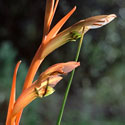 |
|
Gladiolus acuminatus
Endemic to the Western Cape, South
Africa, with a restricted distribution from southwest of
Caledon (near Onrus) to near Bredasdorp. Grows in
renosterveld vegetation at low elevations on stony shale
flats and north-facing slopes. Rarely recorded. Flowers
are greenish-cream to pale yellow with a 22-30 mm long
perianth tube. Flowers from mid-August to late
September. |
|
|
Gladiolus alatus (Kalkoentjie, Red kalkoentjie) Endemic to the Western Cape, South Africa, the distribution
covering the southwestern portion of the province, from the Bokkeveld Escarpment
near Nieuwoudtville south to Cape Town and east to Bredasdorp. Plants occur
mainly on stony sandstone or granitic soils, especially on thin soils and in
rock crevices. It is a pioneer species, resistant to drought, that quickly
colonizes disturbed areas such as road verges and field borders. |
 |
|
Gladiolus albens
Distribution extends from George in
the Western Cape to near Alexandria in the Eastern Cape
and northwards to Somerset East. Grows on grassy slopes
and in low fynbos vegetation on well-drained soils.
Flowers are white to cream with a 35-50 mm long perianth
tube. Probably pollinated by moths. |
|
|
Gladiolus angustus
(Marsh painted lady) Endemic to the
Western Cape, South Africa, the distribution including
Cape Peninsula, the West Coast as far north as about
Vredenburg, inland to Piketberg and the Cedarberg. It
has also been recorded from near Elim (to the west of
Agulhas). The preferred habitat is streams and marshes
on sandstone soils. The long perianth tube and the short
lower tepals with dark red, diamond- or spade-shaped
markings, are distinctive. |
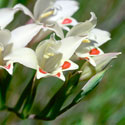 |
|
Gladiolus antholyzoides
Endemic to South Africa, where it
occurs on the central and eastern highveld, from the
eastern Free State, through Gauteng, to the Waterberg
near Nylstroom in Limpopo Province. Has yellow flowers,
55-70 mm long. |
|
|
Gladiolus appendiculatus
Occurs on the eastern escarpment of
southern Africa, from Vryheid in northern KwaZulu-Natal,
across Mpumalanga and Swaziland to Pilgrim's Rest and
Mariepskop. Grows in loamy clay among dolerite rocks in
montane grassland, usually above 1800 m elevation.
Flowers are whitish to pale pink in a straight spike
with brown-tipped overlapping bracts. Anthers are
tailed. |
|
|
Gladiolus aquamontanus
Endemic to the Western Cape, South
Africa, where it is restricted to the Swartberg
mountains. Plants grow in mountain streams and on wet
cliffs. Flowers are mauve-pink with long tubes; probably
pollinated by long-tongued flies. |
|
|
Gladiolus arcuatus
(Kalkoenuintjie, Brown kalkoentjie)
Endemic to South Africa, occurring from the lower
Olifants River valley between Klawer and Vredendal
(Western Cape) northwards to Steinkopf in northern
Namaqualand (Northern Cape), and including the high
country around Springbok and the Kamiesberg. Plants grow
in coarse-grained granite-derived gravel and also in
fine-grained silt. Flowers are a combination of purple
and dull green in colour and have a sweet scent. They
attract bees such as Apis mellifera (Honeybee)
and Anthophora. |
|
|
Gladiolus atropictus
Endemic to the Western Cape, South
Africa, where it has a very restricted distribution on
the northern dry slopes of the Riviersonderend
Mountains, near McGregor. The sweet-scented flowers are
dark blue-violet in colour, with lower tepals pale
yellow below and marked with dark purple lines in a
feathery pattern. Probably pollinated by long-tongued
bees. |
|
|
Gladiolus atropurpureus
A tropical African species with a
distribution including Angola, Burundi, DRC, Malawi,
Mozambique, Tanzania, Zambia and Zimbabwe. Occurs
in deciduous woodland and low montane grassland,
sometimes on rocky outcrops. |
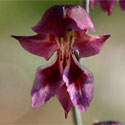 |
|
Gladiolus aurantiacus
Distribution extends from Richmond in
KwaZulu-Natal to southern Mpumalanga and Swaziland,
where it occurs in grassland on moist, stony ground.
Flowers are a deep yellow, dotted or streaked with red
or orange. The perianth tube is 44-70 mm long. |
|
|
Gladiolus aureus
Endemic to the Cape Peninsula,
Western Cape, South Africa where it is restricted to
mountain slopes near Kommetjie and Simonstown. Plants
grow in seeps, where the peaty sand remains wet well
into Spring. |
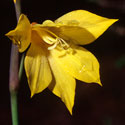 |
|
Gladiolus bilineatus
Endemic to the Western Cape, South
Africa, where it is restricted to the lower southern
slopes of the Langeberg, from Tradouw Pass in the west
to the foot of the mountains north of Riversdale and
Albertinia. Habitat ranges from true fynbos (in Tradouw
Pass) to renosterveld (elsewhere). Flowers are
cream to pink with a long perianth tube. They are
pollinated by the nemestrinid fly Prosoeca
longipennis. |
|
|
Gladiolus blommesteinii
A rare species, endemic to the
Western Cape, South Africa, where it occurs from
Hottentots Holland and Kogelberg mountains eastwards to
Riviersonderend, its distribution including Sir Lowry's
Pass and Franschhoek Pass. Grows in mountain fynbos in
rocky sandstone-derived soils. Flowers from August to
mid-October, mainly within the first two seasons after
fire. Flowers pale blue or pale pink with
purple-streaked nectar guides. Leaves are thin and
elongate. |
|
|
Gladiolus bonaspei
Endemic to the Cape Peninsula,
Western Cape, South Africa, where it occurs on the sandy
plains south of Klaasjagersberg, on the Redhill Plateau
and on the Silvermine Plateau. |
 |
|
Gladiolus brachyphyllus
Occurs in the lowveld of eastern
southern Africa, from Klaserie in the north, through the
central and southeastern regions of the Kruger National
Park, to as far south as Tshaneni in Swaziland. Flowers
are deep pink. |
|
|
Gladiolus brevifolius
(March pypie, Autumn pipes) Endemic to the Western Cape, South Africa, occurring in the
southwestern parts, from Piketberg to the Cape Peninsula and eastwards to the
Agulhas plain and to Montagu. A common autumn flowering species in this region.
Grows in a wide range of soil types from sand to clay. |
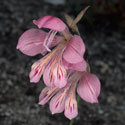 |
|
Gladiolus brevitubus
Endemic to the Western Cape, South
Africa, occurring from the Hottentots Holland Mountains
in the west to Riviersonderend in the east and to the
the Klein River Mountains in the south. Grows on rocky
mountain slopes in sandy soil, at elevations ranging
from 200-1500 m. Flowers are bright orange with a short
perianth tube and do not contain nectar. They appear to
be pollinated by pollen-collecting halictid bees. |
|
|
Gladiolus buckerveldii
Endemic to the Western Cape, South
Africa, with a distribution restricted to the northern
Cedarberg. Plants grow on moist, moss-covered cliffs
with the flowring stems growing out almost horizontally
and the leaves drooping down. |
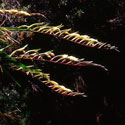 |
|
Gladiolus bullatus
(Caledon bell) Endemic to the Western
Cape, South Africa, with a distribution from Houw Hoek
and Kogelberg in the west to Bredasdorp and Potberg
(near Cape Infanta) in the east. Grows in low-growing
fynbos vegetation, mainly in stony sandstone-derived
soils, but also on limestone outcrops. |
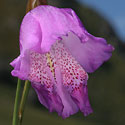 |
|
Gladiolus caeruleus
Endemic to the Western Cape, South
Africa, where it has a very restricted distribution on
the West Coast, extending from Yzerfontein in the south
to the hills above Cape Columbine (north of Saldanha
Bay). Flowers pale blue, speckled with dark purple
against a cream background on the lower three tepals.
Probably pollinated by long-tongued bees. |
|
|
Gladiolus calcaratus
Occurs on the eastern escarpment of
Mpumalanga, from Dullstroom and Kemp's Heights in the
south to Mount Sheba (near Robber's Pass above Pilgrim's
Rest) in the north, thus including Long Tom Pass. Grows
mainly in deeper soils at wet sites, such as around damp
depressions. Pollinated mainly by the long-tongued fly
Prosoeca robusta (Nemestrinidae). Flowers white,
with pale yellow in the throat; older flowers develop a
pink to lilac hue. |
|
|
Gladiolus cardinalis (New Year lily, Waterfall gladiolus)
Endemic to the Western Cape, South Africa, where it
occurs next to waterfalls and on wet cliffs in the
mountains from Bain's Kloof to the Riviersonderend
Mountains. |
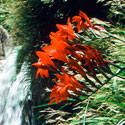 |
|
Gladiolus carinatus
(Blue Afrikaner, Sandpypie)
Distribution is mainly coastal, from central Namaqualand
(Northern Cape) southwards to Cape Town and from there
eastwards to the Knysna vicinity. However, it also
occurs in more mountainous areas inland from the West
Coast. It grows mainly in well drained, sandy soils on
coastal flats, in areas dominated by restio tussocks,
often growing in the restio clump. It also grows on
stony mountain slopes up to 1000 m elevation. |
 |
|
Gladiolus carmineus
(Cliff gladiolus, Hermanus gladiolus) Endemic to the Western Cape, South Africa, where it has a
restricted coastal distribution from Pringle Bay in the west to Cape Infanta in
the east. Plants grown within sight of the sea on outcrops of sandstone, often
on cliffs. |
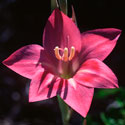 |
|
Gladiolus carneus
(Painted lady, White Afrikaner)
Endemic to the Western Cape, South Africa. Within this
province it occurs in the southern regions from Cape
Town to the Outeniqua Mountains (north of Knysna), and
as far north as Bain's Kloof, and the Witsenberg and
Skurweberg complex north of Ceres. Occurs on the lower
slopes, growing in either shale or sandstone derived
soils, but always in fynbos or on forest margins.
Flowers particularly well after a fire or bush clearing. |
 |
|
Gladiolus caryophyllaceus
(Large pink Afrikaner, Sandveldlelie)
Limited to the Western Cape and Northern Cape, South
Africa, occurring from southern Namaqualand (on the
granite ridges inland from the coast) to Mamre (just
north of Cape Town) and inland to the Bokkeveld
Escarpment, Cedarberg and Hex River Mountains. It has
also been recorded far further east in the Swartberg.
Found in dry habitats, often on open stony ground in
well-drained soils. Often grows in dense clumps of
restios. Flowers are pale to deep pink, mauve or
cream-coloured. |
|
|
Gladiolus cataractarum
A rare endemic to the eastern
escarpment of Mpumalanga, South Africa, occurring from
near Lunsklip Waterfall (south of Dullstroom) to 10 km
further north (towards Lydenburg). Plants grow on
south-facing steep rocky slopes and cliffs, on
quartzite. Flowers are long-tubed and pink, possibly
pollinated by long-tongued nemestrinid flies (but no
observations of this yet). |
|
|
Gladiolus ceresianus
Endemic to the Western Cape, South
Africa, where it occurs in the interior from the Cold
Bokkeveld north of Ceres, eastwards to Matjiesfontein
and then north to the high Roggeveld Escarpment near
Middelpos. Also recorded from Hol River, near Vredendal.
Flowers a complex pattern of mainly purple, yellow and
brown. |
|
|
Gladiolus comptonii
Endemic to the Western Cape, South
Africa, where it is known from only one locality, the
Heerenlogement Mountain at the northwestern end of the
Olifants River Mountains. Plants grow in mountain fynbos
vegetation on the upper slopes from 600-700 m elevation. |
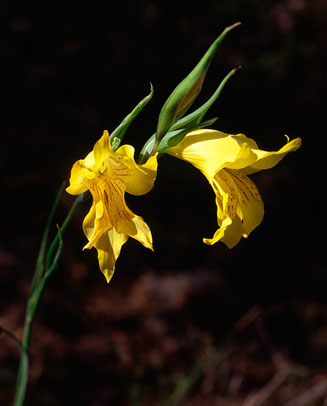 |
|
Gladiolus crassifolius
(Thick-leaved gladiolus) Has a broad distribution that
includes soutwestern Tanzania, Malawi, Mozambique,
Zimbabwe, western Angola, South Africa, Lesotho and
Swaziland. In southern Africa, it occurs from Limpopo
Province, south to Elliot in the Eastern Cape. It also
occurs to the west as far as Krugersdorp and Rustenburg.
Plants grow in grasslands on well-drained rocky
hillsides. |
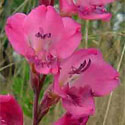 |
|
Gladiolus crispulatus
A rare endemic to the Western Cape,
South Africa, occurring only in the Langeberg, from
Swellendam to Riversdale. Flowers mainly in the first
two years after fire. Flowers are deep pink with a dark
red, median streak on each of the lower tepals. Flowers
mainly from November to December. |
|
|
Gladiolus cruentus
(Blood-red gladiolus, Rooigladiolus, Rooiswardlelie) Endemic to KwaZulu-Natal, South
Africa, where it occurs in the sandstone belt from
Gilletts and Kloof in the south to the Noodsberg and
Kranskop in the north. Plants grow on wet, sandstone
cliffs. Flowers are bright red, with white on the lower
tepals. Flowers from mid-January to early March. |
|
|
Gladiolus cunonius
(Lepelblom) Endemic to the Western
Cape, South Africa, where it has a coastal distribution
extending from Saldanha Bay on the West Coast, round the
Cape Peninsula, to Knysna in the east. Plants grow in
coarse coastal sands in open areas among coastal scrub,
often just above high water mark or on vegetated sand
dunes a short distance inland. |
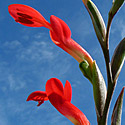 |
|
Gladiolus cylindraceus
Endemic to the Western Cape, South
Africa, where it has a restricted distribution mainly in
the Ceres District, from Mosterthoek Peaks (south of
Mitchell's Pass), northward along the Witzenberg and
Skurweberg ranges to Sneeugat and the Groot Winterhoek
Peaks. Occurs as far east as Waboomsberg (northeast of
Ceres). A montane species, growing above 1500 m
elevation in low growing fynbos on rocky sandstone
slopes and ridges. Flowers pale creamy pink to salmon
with reddish diamond-shaped on the lower tepals. Flowers
from mid-December to late January. |
|
|
Gladiolus dalenii
(Dragon's head lily, Parrot lily, Natal lily, Sword
lily, African gladiolus) Throughout
the grasslands, savannas and woodlands of sub-Saharan
Africa. Its distribution also entends to the highlands
of southwestern Arabia and Madagascar. Most common in
fairly moist habitats, especially in hilly country and
upland grasslands. Flower colours range from red to
orange and yellow to greenish. One of the main species
contributing to Gladiolus hybrid cultivars. |
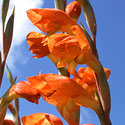 |
|
Gladiolus debilis
(Painted lady) Endemic to the Western Cape, South Africa, where it occurs
from the Cape Peninsula to Bain's Kloof in the northeast, and to Bredasdorp in
the east. Plants grown in fynbos on rocky sandstone slopes. Flower mainly in the
first two to three years after a fire. |
 |
|
Gladiolus decoratus
Native to Tanzania, DRC, Malawi, Zambia, Mozambique. |
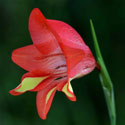 |
|
Gladiolus delpierrei
Endemic to the Western Cape, South
Africa, where there is only one known population, in the
Cedarberg on Sneeuberg and adjacent peaks. Discovered as
recently as 1975, by Georges Delpierre, a mathematician
and bulb enthusiast. Flowers creamy yellow with red
streaks; lower petals dark yellow at the base. Flowers
in December and early January. |
|
|
Gladiolus densiflorus
Occurs in the lowveld and coastal
regions of southern Africa, from Tate Vondo in Limpopo
Province, South Africa, through the Mpumalanga lowveld,
Swaziland, coastal Mozambique, and into KwaZulu-Natal as
far south as Durban. Although mainly in low-lying areas,
it has been recorded as high as 2000 m in the vicinity
of Barberton. Pollinated by long-tongued bees,
particularly Amegilla fallax. Flowers mainly
December to March, but can be any time in northern
KwaZulu-Natal. Flowers cream, greenish, pink, mauve,
slate-grey or orange; usually with pink to purple
speckles. |
|
|
Gladiolus deserticola |
|
|
Gladiolus dolichosiphon |
|
|
Gladiolus dolomiticus |
|
|
Gladiolus ecklonii (Sheathed gladiolus) |
 |
|
Gladiolus elliotii
|
 |
|
Gladiolus emiliae |
|
|
Gladiolus engysiphon |
|
|
Gladiolus equitans
|
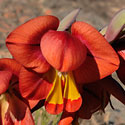 |
|
Gladiolus exiguus |
|
|
Gladiolus exilis |
|
|
Gladiolus ferrugineus |
|
|
Gladiolus filiformis |
|
|
Gladiolus flanaganii |
|
|
Gladiolus flavoviridis |
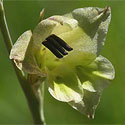 |
|
Gladiolus floribundus
|
 |
|
Gladiolus fourcadei |
|
|
Gladiolus geardii |
|
|
Gladiolus gracilis
|
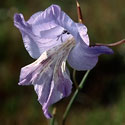 |
|
Gladiolus grandiflorus |
|
|
Gladiolus gregarius
Recorded from Mozambique. |
|
|
Gladiolus griseus
|
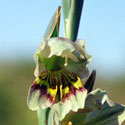 |
|
Gladiolus gueinzii |
|
|
Gladiolus guthriei |
|
|
Gladiolus hirsutus
|
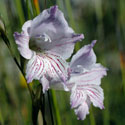 |
|
Gladiolus hollandii |
|
|
Gladiolus huttonii |
|
|
Gladiolus hyalinus |
|
|
Gladiolus inandensis |
|
|
Gladiolus inflatus
|
 |
|
Gladiolus inflexus |
|
|
Gladiolus insolens |
|
|
Gladiolus involutus |
|
|
Gladiolus jonquilliodorus |
|
|
Gladiolus juncifolius |
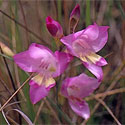 |
|
Gladiolus kamiesbergensis |
|
|
Gladiolus karooicus |
|
|
Gladiolus lapeirousioides |
|
|
Gladiolus leptosiphon |
|
|
Gladiolus lewisiae |
|
|
Gladiolus liliaceus
|
 |
|
Gladiolus longicollis
(Honey flower) |
|
|
Gladiolus loteniensis |
|
|
Gladiolus macneilii |
|
|
Gladiolus maculatus
|
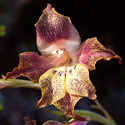 |
|
Gladiolus magnificus |
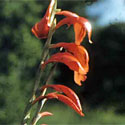 |
|
Gladiolus malvinus |
|
|
Gladiolus marlothii |
|
|
Gladiolus martleyi |
|
|
Gladiolus meliusculus
|
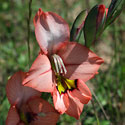 |
|
Gladiolus melleri |
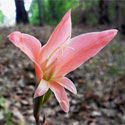 |
|
Gladiolus meridionalis
|
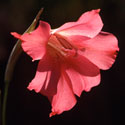 |
|
Gladiolus microcarpus |
|
|
Gladiolus miniatus |
|
|
Gladiolus monticola
|
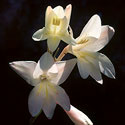 |
|
Gladiolus mortonius |
|
|
Gladiolus mosambicensis |
|
|
Gladiolus mostertiae |
|
|
Gladiolus murielae
[= Gladiolus callianthus]
Recorded from Mozambique. |
 |
|
Gladiolus mutabilis |
|
|
Gladiolus nerineoides |
|
|
Gladiolus nigromontanus |
|
|
Gladiolus oatesii
Occurs in eastern Botswana, northern
regions of South Africa (Northwest Province, Gauteng and
Limpopo) and southern and central Zimbabwe. Grows in
rocky areas of woodland (occasionally open grassland),
where the corms growing between the rocks are protected
from porcupines, baboons and other herbivores. Flowers a
combination of off-white, mauve and purple. |
|
|
Gladiolus ochroleucus
(Triangular gladiolus) |
|
|
Gladiolus oppositiflorus
(Salmon gladiolus, Transkei gladiolus) |
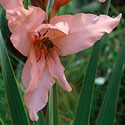 |
|
Gladiolus orchidiflorus |
|
|
Gladiolus oreocharis |
|
|
Gladiolus ornatus |
|
|
Gladiolus overbergensis
|
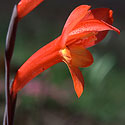 |
|
Gladiolus paludosus |
|
|
Gladiolus papilio
(Butterfly gladiolus) |
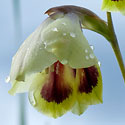 |
|
Gladiolus pardalinus |
|
|
Gladiolus parvulus |
|
|
Gladiolus patersoniae |
|
|
Gladiolus pavonia |
|
|
Gladiolus permeabilis |
|
|
Gladiolus phoenix |
|
|
Gladiolus pole-evansii |
|
|
Gladiolus pretoriensis |
|
|
Gladiolus priorii
|
 |
|
Gladiolus pritzelii |
|
|
Gladiolus pubigerus |
|
|
Gladiolus pulcherrimus
|
 |
|
Gladiolus quadrangularis |
|
|
Gladiolus quadrangulus
|
 |
|
Gladiolus recurvus
|
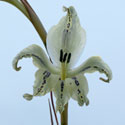 |
|
Gladiolus reginae |
|
|
Gladiolus rehmannii |
|
|
Gladiolus rhodanthus
|
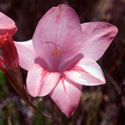 |
|
Gladiolus robertsoniae |
|
|
Gladiolus rogersii
|
 |
|
Gladiolus roseovenosus |
|
|
Gladiolus rubellus |
|
|
Gladiolus rudis |
|
|
Gladiolus rufomarginatus |
|
|
Gladiolus saccatus
|
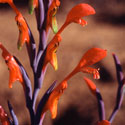 |
|
Gladiolus salteri |
|
|
Gladiolus saundersii
(Saunders' gladiolus, Lesotho lily) |
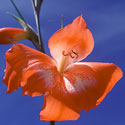 |
|
Gladiolus saxatilis |
|
|
Gladiolus scabridus (Itala
gladiolus) |
|
|
Gladiolus scullyi
|
 |
|
Gladiolus sekukuniensis |
|
|
Gladiolus sempervirens
|
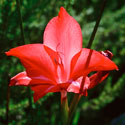 |
|
Gladiolus sericeovillosus
(Large speckled gladiolus) |
|
|
Gladiolus serpenticola |
|
|
Gladiolus speciosus |
|
|
Gladiolus splendens |
|
|
Gladiolus stefaniae |
|
|
Gladiolus stellatus |
|
|
Gladiolus stokoei |
|
|
Gladiolus subcaeruleus |
|
|
Gladiolus sufflavus |
|
|
Gladiolus symonsii |
|
|
Gladiolus taubertianus |
|
|
Gladiolus teretifolius |
|
|
Gladiolus trichonemifolius |
|
|
Gladiolus tristis |
|
|
Gladiolus uitenhagensis |
|
|
Gladiolus undulatus
|
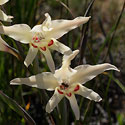 |
|
Gladiolus unguiculatus
A tropical African species with a broad distribution
extending from Senegal and Sudan to northern Zimbabwe,
where it grows in flat areas with permanent or seasonal
wetlands. |
 |
|
Gladiolus uysiae
|
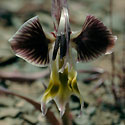 |
|
Gladiolus vaginatus |
|
|
Gladiolus vandermerwei |
|
|
Gladiolus variegatus |
|
|
Gladiolus varius |
|
|
Gladiolus venustus |
|
|
Gladiolus vernus |
|
|
Gladiolus vigilans |
|
|
Gladiolus vinosomaculatus |
|
|
Gladiolus violaceolineatus |
|
|
Gladiolus virescens |
|
|
Gladiolus virgatus |
|
|
Gladiolus viridiflorus |
|
|
Gladiolus watermeyeri |
|
|
Gladiolus watsonius |
 |
|
Gladiolus wilsonii
|
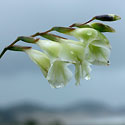 |
|
Gladiolus woodii |
|
|
Gladiolus zimbabweensis
Recorded from Zimbabwe and Mozambique. |
 |
|
Gladiolus x lewisiae |
|
